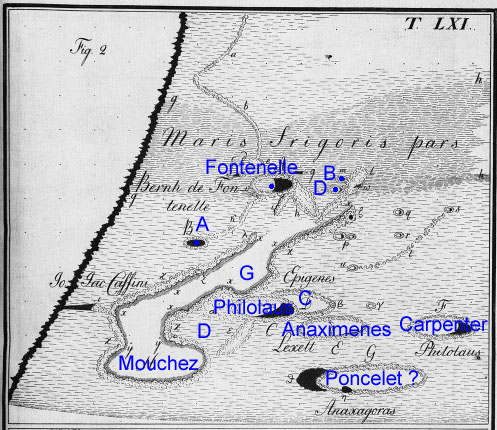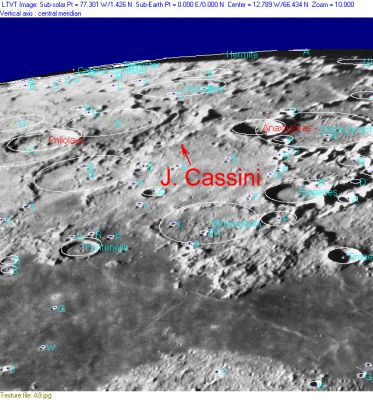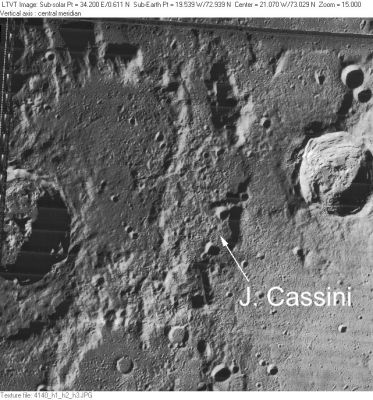Difference between revisions of "J. Cassini"
| Line 6: | Line 6: | ||
|- | |- | ||
| | | | ||
| − | [http://www.lpod.org/coppermine/albums/userpics/J-Cassini_CLA-A9_LTVT.JPG [[Image: | + | [http://www.lpod.org/coppermine/albums/userpics/J-Cassini_CLA-A9_LTVT.JPG [[Image:Normal_J-Cassini_CLA-A9_LTVT.JPG|external image normal_J-Cassini_CLA-A9_LTVT.JPG]]]<br /> |
| | | | ||
| − | [http://www.lpod.org/coppermine/albums/userpics/J-Cassini_LO-IV-140H_LTVT.JPG [[Image: | + | [http://www.lpod.org/coppermine/albums/userpics/J-Cassini_LO-IV-140H_LTVT.JPG [[Image:Normal_J-Cassini_LO-IV-140H_LTVT.JPG|external image normal_J-Cassini_LO-IV-140H_LTVT.JPG]]]<br /> |
|} | |} | ||
Left''':''' Earth-based view (shown with zero libration) of ''[http://lpod.org/coppermine/displayimage.php?pos=-2446 Consolidated Lunar Atlas plate A9]''. As nearly as can be determined, the discontinued IAU name denoted the feature indicated by the arrow, which was described as a valley by the early observers. '''J. J. Cassini''' is midway between [[Philolaus|Philolaus]] (west, or left) and [[Anaxagoras|Anaxagoras]] (east, or right) (labeled in red -- to read the other labels, click for the full-sized image).<br /> Right''':''' North-up aerial view from ''[http://lpod.org/coppermine/displayimage.php?pos=-2455 Lunar Orbiter IV-140H]''. In this view, 70 km [[Philolaus|Philolaus]] is on the left and 50 km [[Anaxagoras|Anaxagoras]] on the right. The crater straddling the bottom margin is '''Philolaus G''' (seems to be unnamed on the ''LROC Act-React Quick Map''), while the larger of the two little craters in the upper right corner is '''[[Goldschmidt|Goldschmidt]] D'''. The [[Blagg%20and%20M%C3%BCller|Blagg and Müller]] position for what they called '''J. J. Cassini''' plots in the center of the valley. In the present IAU interpretation (where '''J. J. Cassini''' is no longer recognized) the west wall of the valley is regarded as a part of the east rim of the 91 km '''Philolaus D''', while the valley itself, and the hills forming its east wall (which look like they might be remnants of the rim of a larger crater centered at roughly the same location), are unnamed.<br /> <br /> <div id="toc"> | Left''':''' Earth-based view (shown with zero libration) of ''[http://lpod.org/coppermine/displayimage.php?pos=-2446 Consolidated Lunar Atlas plate A9]''. As nearly as can be determined, the discontinued IAU name denoted the feature indicated by the arrow, which was described as a valley by the early observers. '''J. J. Cassini''' is midway between [[Philolaus|Philolaus]] (west, or left) and [[Anaxagoras|Anaxagoras]] (east, or right) (labeled in red -- to read the other labels, click for the full-sized image).<br /> Right''':''' North-up aerial view from ''[http://lpod.org/coppermine/displayimage.php?pos=-2455 Lunar Orbiter IV-140H]''. In this view, 70 km [[Philolaus|Philolaus]] is on the left and 50 km [[Anaxagoras|Anaxagoras]] on the right. The crater straddling the bottom margin is '''Philolaus G''' (seems to be unnamed on the ''LROC Act-React Quick Map''), while the larger of the two little craters in the upper right corner is '''[[Goldschmidt|Goldschmidt]] D'''. The [[Blagg%20and%20M%C3%BCller|Blagg and Müller]] position for what they called '''J. J. Cassini''' plots in the center of the valley. In the present IAU interpretation (where '''J. J. Cassini''' is no longer recognized) the west wall of the valley is regarded as a part of the east rim of the 91 km '''Philolaus D''', while the valley itself, and the hills forming its east wall (which look like they might be remnants of the rim of a larger crater centered at roughly the same location), are unnamed.<br /> <br /> <div id="toc"> | ||
| Line 19: | Line 19: | ||
<br /> | <br /> | ||
==Description: Elger== | ==Description: Elger== | ||
| − | ''([[IAU% | + | ''([[IAU%20directions|IAU Directions]])'' North of [[Fontenelle|Fontinelle]], extending towards [[Goldschmidt|Goldschmidt]] and the limb, Schroter discovered a very wide irregular valley which he named "J.J. Cassini." It is really nothing more than a great plain bounded by ridges. At 9 h. October 15, 1888, when [[Philolaus|Philolaus]] was on the morning terminator, I had a fine view of it, and, as regards its general shape, found that it agreed very closely with [http://gallica.bnf.fr/ark:/12148/btv1b2600117x.item.langEN.f56.pagination Schroter's drawing].<br /> <br /> |
==Additional Information== | ==Additional Information== | ||
* See Plates [http://www.lpi.usra.edu/resources/cla/info/a12 A12] and [http://www.lpi.usra.edu/resources/cla/info/a13 A13] from the ''[[Consolidated%20Lunar%20Atlas|Consolidated Lunar Atlas]]'' for something similar to Elger's view on October 15, 1888. | * See Plates [http://www.lpi.usra.edu/resources/cla/info/a12 A12] and [http://www.lpi.usra.edu/resources/cla/info/a13 A13] from the ''[[Consolidated%20Lunar%20Atlas|Consolidated Lunar Atlas]]'' for something similar to Elger's view on October 15, 1888. | ||
Revision as of 01:55, 16 April 2018
Contents
J. Cassini
(discontinued IAU name; formerly J. J. Cassini)
| Lat: 73°N, Long: 20°W, Diam: , Depth: km, Rükl: 3 | |
Right: North-up aerial view from Lunar Orbiter IV-140H. In this view, 70 km Philolaus is on the left and 50 km Anaxagoras on the right. The crater straddling the bottom margin is Philolaus G (seems to be unnamed on the LROC Act-React Quick Map), while the larger of the two little craters in the upper right corner is Goldschmidt D. The Blagg and Müller position for what they called J. J. Cassini plots in the center of the valley. In the present IAU interpretation (where J. J. Cassini is no longer recognized) the west wall of the valley is regarded as a part of the east rim of the 91 km Philolaus D, while the valley itself, and the hills forming its east wall (which look like they might be remnants of the rim of a larger crater centered at roughly the same location), are unnamed.
Images
LPOD Photo Gallery Lunar Orbiter Images
Maps
(LAC zone 3A3) USGS Digital Atlas PDF
Description
Description: Elger
(IAU Directions) North of Fontinelle, extending towards Goldschmidt and the limb, Schroter discovered a very wide irregular valley which he named "J.J. Cassini." It is really nothing more than a great plain bounded by ridges. At 9 h. October 15, 1888, when Philolaus was on the morning terminator, I had a fine view of it, and, as regards its general shape, found that it agreed very closely with Schroter's drawing.
Additional Information
- See Plates A12 and A13 from the Consolidated Lunar Atlas for something similar to Elger's view on October 15, 1888.
Nomenclature
- Named for Jacques Cassini (1677-1756); son of G. D. Cassini (founder of a dynasty of famous French astronomers, prominent at the Paris Observatory).
- As indicated by Elger, the name J.J. Cassini (actually "Jo. Jac. Cassini") was introduced by Johann Schröter as illustrated in Plate 61 from Volume 2 of his book. Schröter's north-down drawing is reproduced below with most likely equivalent modern names superimposed (the text would have to be consulted to determine the significance of the dark shadow, and hence the identity, of the feature labeled "Anaxagoras/Poncelet?"):
 Some of these are new names added by Schröter. Others are ones from Riccioli, which Schröter has identified differently from later observers, like Beer and Mädler, who had more influence on the modern nomenclature (the drawing of the north polar region in Riccioli's map is so ambiguous there is no reason to think one set of "identifications" is better than any other). With the exception of Fontenelle and J.J. Cassini, Schröter's other suggestions shown here were used elsewhere.
Some of these are new names added by Schröter. Others are ones from Riccioli, which Schröter has identified differently from later observers, like Beer and Mädler, who had more influence on the modern nomenclature (the drawing of the north polar region in Riccioli's map is so ambiguous there is no reason to think one set of "identifications" is better than any other). With the exception of Fontenelle and J.J. Cassini, Schröter's other suggestions shown here were used elsewhere.
- The name introduced by Schröter was part of the original IAU nomenclature of Blagg and Müller (1935), where it had two satellite craters.
- Gerard Kuiper thought the second "J" was superfluous and shortened the name to J. Cassini in 1961.
- Shortly thereafter, that feature was deleted from the IAU nomenclature by Arthur et. al in preparing their Rectified Lunar Atlas and System of Lunar Craters (IAU Transactions XIIB, 1964). Apparently they felt this was one of those formations not "worthy" of a name. The commemoration of J. Cassini was “moved” (Whitaker, p. 235) to the better-known crater Cassini in the eastern hemisphere (previously honoring his father, G. D. Cassini, alone). - Jim Mosher
- According to Schafarik (1877), the "J. J." in Schröter's name stood for "John James", although this Cassini is only rarely referred to as "J. J.". Schafarik's initial reference to J.J. Cassini being located in the region of Riccioli's Meton and Euctemon is puzzling, since according to Whitaker Riccioli's Meton and Euctemon were the same as the present ones (and they are in the eastern hemisphere). Elsewhere, Schafarik is clearly talking about the present feature. - Jim Mosher
LPOD Articles
Bibliography
- Schafarik, A. (1877). On the Lunar Valley J. J. Cassini of Schröter. Astronomical Register Vol. 15, pp. 263-8. (Is this Bohemian astronomer related to the Vojtěch Safarik for whom a crater is named??)

